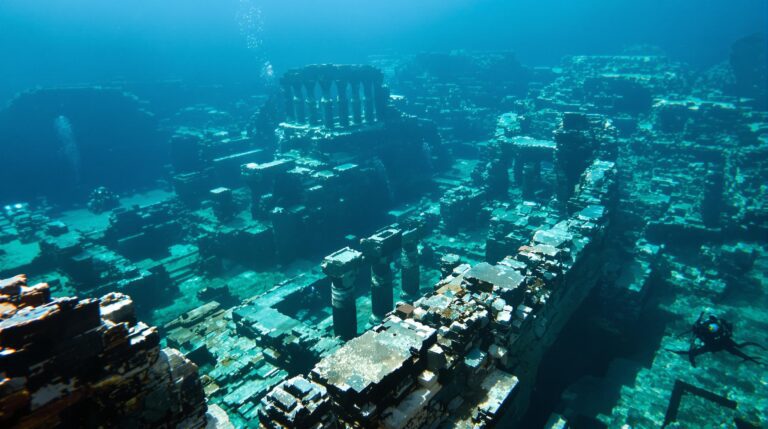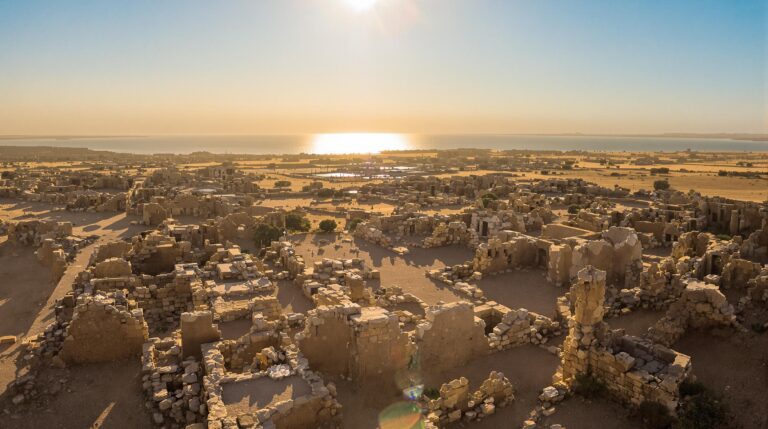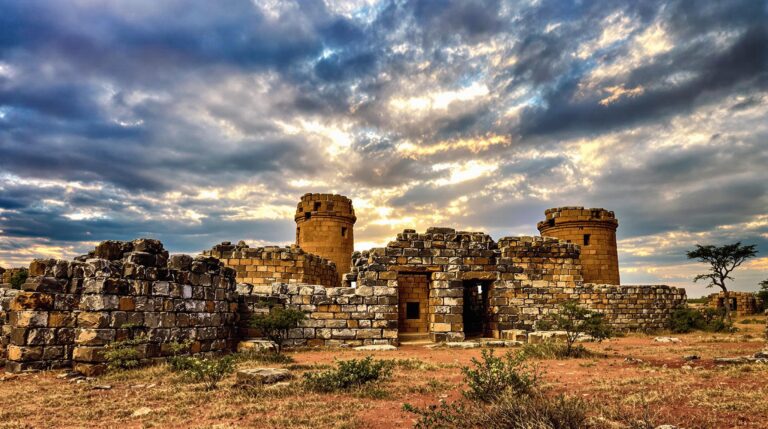Timgad: Rome’s African Ghost Town
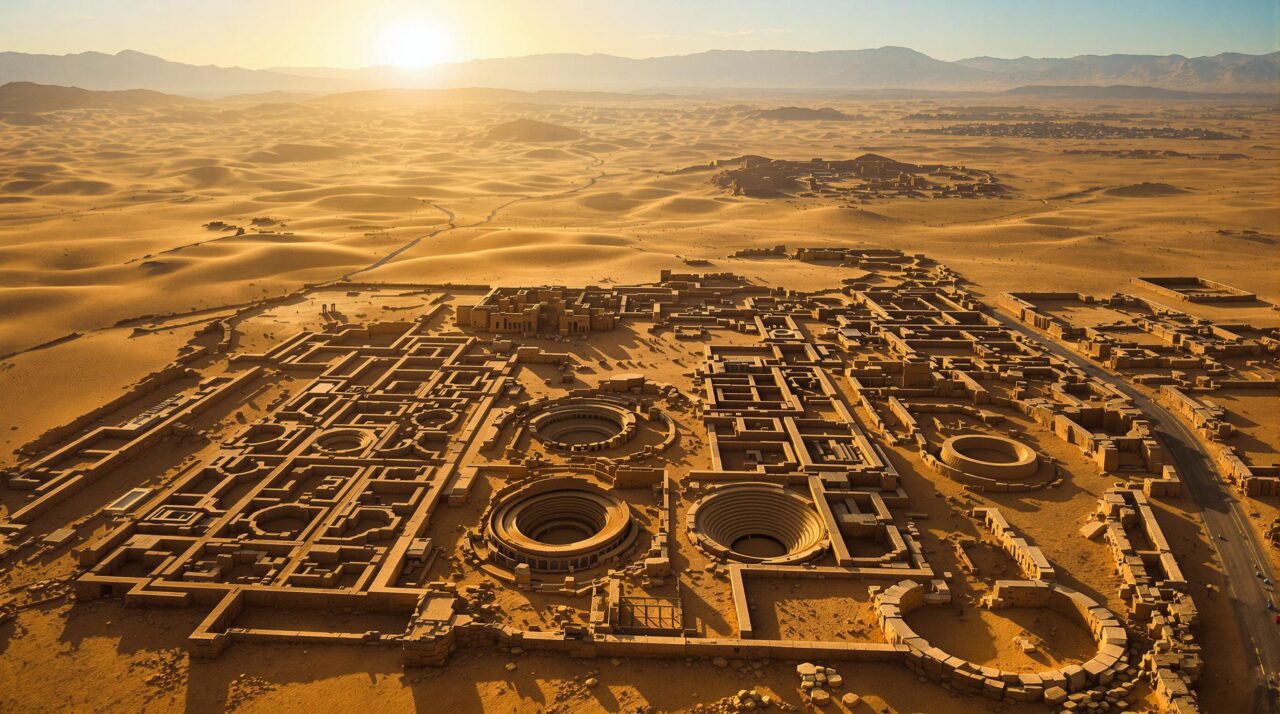
Timgad, a forgotten jewel of Roman ambition, lies in the arid expanse of North Africa.
Its grid-like streets whisper tales of a once-thriving metropolis, where Roman and Berber cultures intertwined seamlessly.
Yet, beneath its sun-baked ruins, an air of desolation lingers, hinting at the cataclysmic events that silenced its lively pulse. What forces brought this grand city to its knees?
The answers may reveal a deeper narrative of civilization’s fragility.
Principal Conclusions
Hide- Timgad, established under Emperor Trajan, was a Roman military outpost in North Africa, showcasing Roman ambition and urban planning.
- The city served as a vital cultural and trade crossroads, blending Roman and indigenous Berber influences.
- Environmental shifts and invasions led to Timgad's decline, transforming it into a haunting ghost town of ruins.
- Rediscovered in the 19th century, Timgad's archaeological significance highlights Roman architecture and daily life in an ancient colony.
- Now a UNESCO World Heritage site, Timgad faces conservation challenges amidst growing global interest in its historical legacy.
The Birth of Timgad in Roman North Africa
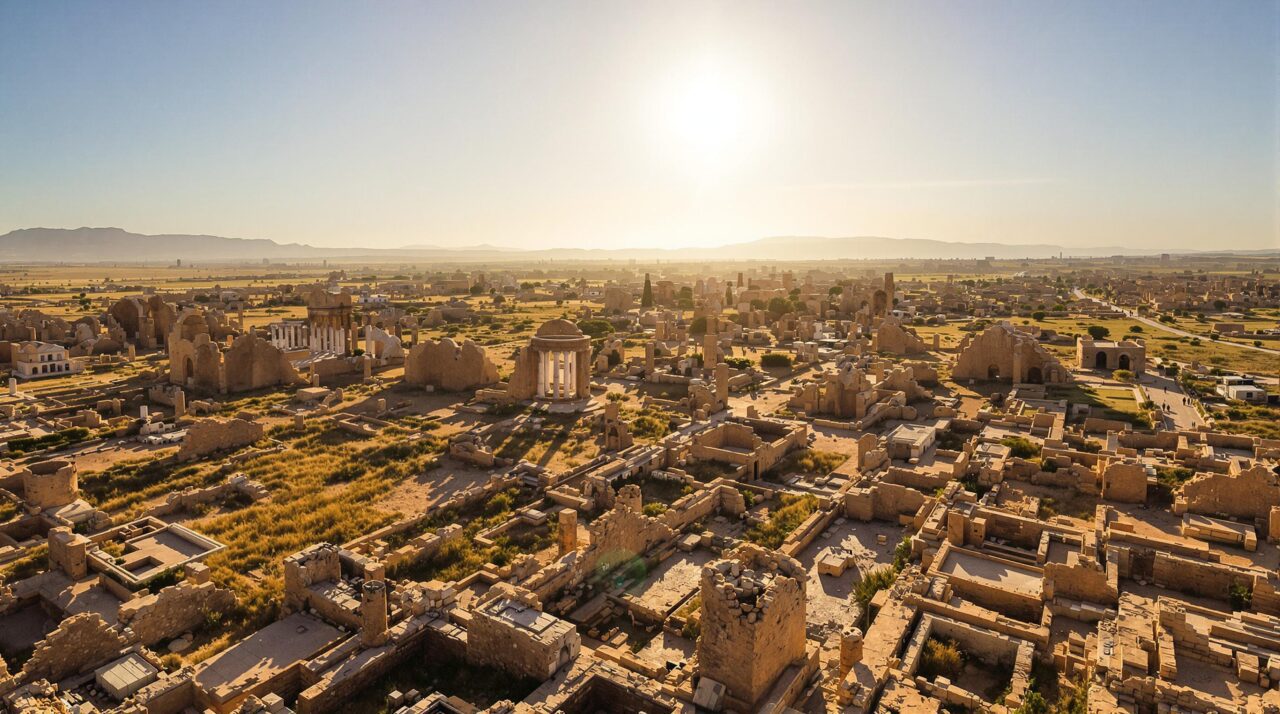
Nestled amid the rugged peaks of the Aurès Mountains, Timgad emerged as a monument to Roman ambition under Emperor Trajan’s rule.
Its strategic location not only provided a natural fortress but also served as an essential hub for trade and military movement across North Africa.
As the sun cast shadows over its meticulously planned streets, the city became a lively reflection of imperial power and cultural exchange.
Strategic Location in the Aurès Mountains
Nestled at the foothills of the Aurès Mountains, Timgad emerged as a calculated bastion for Rome, its strategic location offering both protection and a gateway to the vast Sahara.
This ancient city not only fortified the empire’s African frontier but also served as a lively crossroads of culture and commerce, echoing the ambitions of Roman expansion.
As the sun cast long shadows across its ruins, the remnants of Timgad whisper tales of a time when it stood as a sentinel against the encroaching desert and the unknown beyond.
Why Rome Chose the Edge of the Sahara
As the Roman Empire expanded its reach across North Africa, the choice to establish Timgad at the edge of the Sahara was a calculated decision, blending strategic foresight with an appreciation for the region’s unique geography.
Nestled against the Aurès Mountains, Timgad offered fertile land, crucial trade routes, and a natural defense, creating a lively outpost that echoed the empire’s ambitions amidst the desert’s vastness.
Role in Securing the African Frontier
Timgad emerged as a pivotal stronghold in the Roman Empire’s efforts to secure its African frontier, strategically positioned against the backdrop of the Aurès Mountains.
This military outpost served as a bulwark against potential threats, ensuring the stability of trade routes and cultural exchange.
Its design reflected both Roman ingenuity and the unyielding spirit of a civilization determined to protect its dominion.
Founded Under Emperor Trajan
Amidst the rugged grandeur of the Aurès Mountains, Timgad emerged as a tribute to Emperor Trajan’s vision, a carefully crafted outpost that blended military might and urban design.
Established as a Roman colony, its very foundation was steeped in purpose, aimed at securing the empire’s northern frontiers while fostering cultural assimilation.
The legacy of these military colonies would resonate through the ages, echoing tales of conquest, community, and the indelible mark of Roman civilization on African soil.
Purpose Behind Its Establishment
Although the sands of time have shifted relentlessly over centuries, the founding of Timgad under Emperor Trajan stands as a reflection of Rome’s ambitious reach into the heart of North Africa.
Established as a strategic military outpost and a symbol of Roman civilization, Timgad was designed to cultivate commerce, spread culture, and assert dominance, intertwining local traditions with imperial aspirations in a lively tapestry of life.
Roman Military Colonies and Their Legacy
As the sun cast long shadows over the arid landscape of North Africa, the establishment of Roman military colonies served as a pivotal strategy in consolidating Rome’s power across its vast empire.
Timgad emerged as a striking representation of this ambition, blending military might with cultural exchange, leaving a legacy that echoes through history, reminding future generations of the complex interplay between conquest and civilization.
Urban Layout and Roman Planning Precision
Timgad’s urban layout unfolds like a meticulously drawn map, where the grid system reflects the disciplined order of Rome itself.
Wide avenues converge upon lively public spaces, inviting the echoes of bustling marketplaces and communal gatherings that once animated the town.
This architectural precision not only underscores Roman ingenuity but also speaks to a vision of civilization, meticulously crafted in the sands of North Africa.
Grid System That Mirrored Rome’s Order
In the heart of Timgad, the Decumanus Maximus and Cardo Maximus stand as silent sentinels, remnants of a meticulously planned urban landscape that echoes the precision of Roman engineering.
This grid system, a reflection of the ideals of order and balance, reflects the empire’s ambition to impose civilization on the wilds of Africa.
Each intersection, a crossroads of commerce and culture, invites contemplation on the harmonious blend of functionality and aesthetics that defined Roman urban planning.
Decumanus Maximus and Cardo Maximus Explained
The urban layout of Timgad, a striking demonstration of Roman ingenuity, reveals the meticulous planning underlying its grid system, dominated by the Decumanus Maximus and Cardo Maximus.
These grand thoroughfares intersected at right angles, reflecting an ordered vision of life. Each street, paved with purpose, guided free citizens through a harmonious blend of commerce and community, echoing the ideals of civilization’s finest hour.
How the City Reflected Roman Ideals of Order
While exploring the remnants of Timgad, one cannot help but notice how its urban design embodies the Roman ideals of order and precision.
The meticulous grid layout, with its intersecting streets and evenly spaced buildings, reflects a civilization that valued harmony.
Each pathway invites the spirit of freedom, guiding wanderers through the echoes of a structured world, where chaos was vanquished by foresight and design.
Public Spaces and Infrastructure
In the heart of Timgad, remnants of grand forums, intricate baths, and majestic amphitheaters whisper tales of a meticulously planned society.
The careful arrangement of public spaces reflects not only Roman architectural brilliance but also a sophisticated understanding of community life, where leisure and civic duty intertwined seamlessly.
Amidst the arid landscape, aqueducts stand as monuments of ingenuity, channeling life-giving water to sustain the lively pulse of this ancient city.
Forums, Baths, Libraries, and Amphitheaters
Amid the sun-drenched ruins of Timgad, the remnants of its grand public spaces reveal an intricate tapestry of Roman urban planning, where every forum, bath, library, and amphitheater was meticulously designed to reflect the ideals of civic life and social interaction.
These structures, adorned with elegant columns and colorful mosaics, once served as lively hubs, pulsating with the energy of community and the pursuit of knowledge.
Aqueducts and Water Management in a Dry Region
As the relentless sun beat down on the arid landscape surrounding Timgad, the ingenuity of Roman engineering came to life through its aqueducts, which stood as monumental symbols to the civilization’s mastery over water management.
These structures, intricate and purposeful, channeled life-giving water across the dry expanse, enabling flourishing public spaces and lively community life, thereby reflecting the Romans’ profound understanding of urban planning and environmental adaptation.
Daily Life in a North African Roman City
In the sun-drenched streets of Timgad, the rhythms of daily life unfolded against a backdrop of Roman grandeur, where the mingling of civilian and veteran populations painted a complex social tapestry.
Lively markets bustled with the exchange of goods, while temples echoed with the prayers of a diverse array of deities, reflecting the rich cultural mosaic that characterized this North African city.
As the sun set over the colonnaded ruins, the interplay of commerce, religion, and tradition revealed a society thriving amidst the echoes of history.
Civilian and Veteran Populations
In the sun-drenched streets of Timgad, a lively tapestry of civilian and veteran lives unfolded, where Roman settlers and indigenous Berbers wove their traditions into a shared existence.
The bustling agora echoed with the sounds of trade and laughter, each corner reflecting the intricate interplay of cultures that defined daily life in this North African gem.
Here, amid the ruins, the stories of soldiers turned farmers and merchants blending rites and customs linger like whispers in the wind.
Who Lived in Timgad and Their Roles
Timgad, a striking tribute to Roman architectural prowess, echoed with the footsteps of diverse inhabitants who shaped its dynamic community.
Civilians engaged in commerce and craftsmanship, while retired soldiers, having earned their land, contributed to local governance.
Together, they forged a vibrant tapestry of daily life, where the hum of trade blended with the laughter of children, embodying a shared pursuit of freedom and prosperity.
The Blending of Roman and Berber Traditions
As the sun dipped below the horizon, casting a warm glow over the ancient streets, the confluence of Roman and Berber traditions became palpable in Timgad.
Lively markets echoed with the mingling of Latin and Tamazight, while architectural marvels reflected both cultures.
This fusion enriched daily life, blending Roman governance with Berber customs, creating a unique tapestry of resilience and collaboration in a thriving community.
Commerce, Religion, and Culture
In the bustling streets of Timgad, the lively pulse of commerce intertwined seamlessly with the sacred rhythms of daily life.
Merchants from distant Sahara trade routes exchanged exotic goods beneath the watchful eyes of marble temples, where deities were both revered and invoked in rituals that shaped the community’s spiritual landscape.
This confluence of trade and faith painted a complex tapestry of culture, revealing how the ancient city thrived at the crossroads of commerce and religion.
Markets and Trade Routes Connecting the Sahara
Nestled amidst the undulating sands of the Sahara, Timgad emerged as a bustling nexus of trade and cultural exchange, where the lively pulse of commerce breathed life into the arid landscape.
Caravans laden with precious silks and spices traversed ancient routes, weaving connections between distant lands. Markets thrived, echoing with spirited bartering, as diverse cultures converged, fostering a colorful mosaic of shared ambitions and dreams.
Temples, Deities, and Spiritual Practices
Although the sun-baked ruins of Timgad now stand silent, echoes of its lively spiritual life once filled the air with fervor and devotion.
Temples dedicated to diverse deities adorned the city, where citizens engaged in rituals that intertwined daily life with the divine.
Offerings, incense, and prayers created a tapestry of belief, reflecting a society deeply connected to the cosmic forces shaping their existence.
Timgad’s Decline and Sudden Silence
As the lively pulse of Timgad began to wane, environmental shifts clashed with political turmoil, casting shadows over its once-bustling streets.
The whispers of its inhabitants faded, swallowed by the encroaching sands that slowly buried the remnants of a once-thriving civilization.
In this haunting stillness, the ruins stood as silent witnesses to a forgotten era, echoing the mysteries of abandonment and loss.
Environmental and Political Shifts
As the relentless sands of the desert began their slow, inevitable advance, Timgad’s once-thriving fields succumbed to agricultural despair, leaving echoes of its former vibrancy.
The political landscape shifted dramatically, as invasions stripped away the Roman influence, leaving the city to grapple with an uncertain fate.
In this perfect storm of environmental decay and crumbling authority, Timgad fell silent, a haunting memorial to the fragility of civilization.
Desert Encroachment and Agricultural Struggles
How did the once-thriving city of Timgad succumb to the relentless march of desert sands? The encroachment transformed fertile fields into barren expanses, leaving its inhabitants vulnerable.
- Overgrazing and deforestation
- Climate shifts and prolonged droughts
- Soil erosion and degradation
- Economic instability and migration
- Disconnection from trade routes
These factors converged, silencing the lively echoes of Timgad’s past, as nature reclaimed its dominion.
Invasions and Loss of Roman Control
While the desert winds whispered secrets of a bygone era, Timgad’s fate was sealed not only by environmental shifts but also by the encroaching shadows of invaders.
Waves of tribes surged forth, dismantling Roman control and eroding the once-vibrant community. Political instability and relentless assaults left the city desolate, a haunting symbol of the fragility of civilization amidst the relentless march of time.
Abandonment and Burying Beneath the Sands
As the winds of time swept through Timgad, the once-vibrant city gradually succumbed to silence, its grandeur fading into the whispers of history.
Burying its splendor beneath layers of sand, the town transformed into an enigmatic relic, lost to the ages and forgotten by the world.
Centuries later, the enduring echoes of its past would beckon explorers, igniting curiosity about a civilization that once thrived in the heart of North Africa.
The Gradual Fade from History
What forces conspired to silence the once-thriving city of Timgad, transforming it into a mere whisper of its former glory?
The decline was gradual yet profound, driven by:
- Economic instability
- Invasions and conflicts
- Environmental changes
- Declining trade routes
- A shift in power dynamics
As the sands of time settled, Timgad’s lively echoes faded, succumbing to the silence of abandonment.
Forgotten Until Rediscovery Centuries Later
The once-bustling streets of Timgad, now silenced by the passage of time, lay hidden beneath layers of sand and history, their lively echoes replaced by an eerie stillness.
Abandoned and forgotten, the town’s remnants blended into the desert landscape, awaiting rediscovery.
Centuries later, archaeologists unearthed its secrets, revealing a ghost town that still whispered stories of a colorful past yearning to be heard.
Rediscovery and Archaeological Revelations
In the 19th century, Timgad emerged from its centuries-long slumber, revealing a tapestry of Roman life woven into its crumbling stones.
As archaeologists brushed away the dust of ages, each fragment unearthed whispered secrets of daily existence, governance, and culture in this once-thriving city.
Today, the ruins stand as poignant reminders, inviting contemplation on the enduring legacy of a civilization that flourished in the sands of North Africa.
Unearthing the City in the 19th Century
In the mid-19th century, French archaeologists commenced a journey into the sun-baked sands of Timgad, unearthing remnants of a once-thriving Roman city.
Their painstaking excavations revealed intricately mosaicked floors and grand public edifices, transforming perceptions of Roman influence in Africa.
Each discovery whispered secrets of a lively civilization, reshaping the narrative of history and illuminating the enduring legacy of this forgotten town.
Initial Excavations by French Teams
Uncovering the remnants of Timgad in the 19th century captivated French archaeologists, igniting a fervor for discovery that would disclose the city’s remarkable past.
Their efforts revealed:
- Intricate mosaics depicting lively scenes
- Well-preserved public buildings
- An expansive grid layout
- Ancient inscriptions revealing local culture
- Artifacts reflecting daily life
These findings breathed life into the once-forgotten ghost town, illuminating its storied existence.
Discoveries That Changed Roman African History
Rediscovery of Timgad not only revealed a ghost town but also reshaped the understanding of Roman influence in Africa.
As archaeologists unearthed intricate mosaics and monumental structures, the city emerged as a demonstration of Roman ingenuity and cultural exchange.
These revelations illuminated the complexities of colonial dynamics, showcasing Timgad as a lively nexus of trade and knowledge, forever altering perceptions of Africa’s historical landscape.
What the Ruins Tell Us Today
The ruins of Timgad stand as silent storytellers, revealing inscriptions and artifacts that whisper secrets of a once-thriving Roman city.
Each fragment of pottery and crumbling civic structure invites an analysis of daily life, governance, and the cultural tapestry woven into this ancient landscape.
As the dust of centuries settles, the remnants emerge not just as relics, but as crucial clues to understanding the complexities of a civilization frozen in its final chapter.
Inscriptions, Artifacts, and Civic Structures
Beneath the sun-drenched sands of Timgad, inscriptions and artifacts whisper stories of a once-thriving Roman colony, revealing the intricate tapestry of daily life and governance in this ancient outpost.
Key discoveries include:
- Elaborate mosaics depicting mythological scenes
- Civil inscriptions detailing local governance
- Everyday pottery illustrating daily routines
- Monumental arches celebrating military victories
- Public baths showcasing social customs
Each piece enriches the narrative of Timgad’s past.
A City Frozen in Its Final Chapter
Amidst the silent ruins of Timgad, a haunting narrative unfolds, capturing the essence of a civilization frozen in time.
Archaeological discoveries breathe life into the ancient streets, revealing whispers of daily existence and cultural richness.
Each crumbling column and mosaic fragment tells a story, inviting freedom-seeking minds to ponder the aspirations and dreams of those who once thrived in this forgotten city.
Timgad’s Cultural Significance Today
Timgad stands as a tribute to Rome’s far-reaching influence, its ruins whispering tales of a civilization that once thrived in North Africa.
Recognized by UNESCO, this ghost town captivates global interest, drawing scholars and tourists alike who seek to understand the intricate tapestry of cultural exchange.
Through its preserved structures and artifacts, Timgad offers profound insights into the melding of local traditions with imperial ambition, illuminating the legacy of a once-vibrant Roman frontier.
UNESCO Recognition and Global Interest
Timgad stands as a silent monument to ancient Roman ingenuity, its ruins whispering stories of a once-thriving civilization.
Recognized by UNESCO, it embodies a vibrant mosaic of cultural significance that attracts scholars and travelers alike, yet it faces the relentless threat of erosion and neglect.
As global interest in preserving such historical gems grows, the challenge remains to balance conservation efforts with raising awareness of Timgad’s invaluable heritage.
Why Timgad Holds Enduring Importance
How does a silent city, steeped in the echoes of antiquity, continue to captivate the imagination of modern society?
Timgad, a proof of Roman ingenuity, remains significant for various reasons:
- UNESCO World Heritage status
- Architectural marvel of Roman urban planning
- Symbol of cultural exchange
- Insight into ancient daily life
- Site for scholarly research and tourism
Its allure transcends time, inviting exploration and reflection.
Challenges in Conservation and Awareness
While the remnants of ancient grandeur whisper stories of a bygone era, the challenges of conservation and public awareness loom large over Timgad’s ongoing narrative.
UNESCO recognition highlights its significance, yet funding and local engagement remain critical hurdles.
As global interest grows, the risk of neglect threatens to overshadow Timgad’s legacy, urging a harmonious balance between preservation and the lively storytelling of its historical essence.
What Timgad Teaches About Rome’s Reach
Timgad stands as a silent evidence to Rome’s expansive influence, its meticulously planned grid echoing the grandeur of imperial ambition.
The town’s rise and eventual abandonment narrate a poignant story of cultural exchange and the fleeting nature of power within the African landscape.
As the ruins whisper tales of a once-thriving civilization, they invite reflections on how empires shape and are ultimately shaped by the territories they touch.
Lessons from Its Design, Rise, and Disappearance
What lessons can be gleaned from the ruins of Timgad, a once-thriving Roman settlement nestled in the arid landscapes of North Africa?
- Urban planning reflects adaptability.
- Cultural exchanges shaped identities.
- Economic structures reveal vulnerabilities.
- Architectural innovations demonstrate ambition.
- Environmental factors influence sustainability.
These elements together illustrate the intricate tapestry of civilization, offering insights into resilience and the impermanence of human endeavors.
Reflections on Empire and Its Footprints in Africa
How does the legacy of an ancient empire echo through the remnants of a forgotten town?
Timgad stands as a symbol of Roman ambition, its ruins whispering tales of conquest and cultural exchange.
Each stone reflects the complexities of imperial reach, revealing both the grandeur and fragility of civilization.
In its silence, Timgad invites contemplation on the enduring impact of empire in Africa’s diverse tapestry.
Wrapping Up
Timgad stands today like a whispering echo of a once-vibrant civilization, its ruins a canvas where the colors of Roman and Berber cultures bleed into one another.
As the sands of time shift, they reveal not only the fragility of human achievement but also the profound connections forged through cultural exchange.
This ghost town, now a UNESCO World Heritage site, invites contemplation on the impermanence of life and the enduring legacies that shape our understanding of history.

